|
|
|

|
|
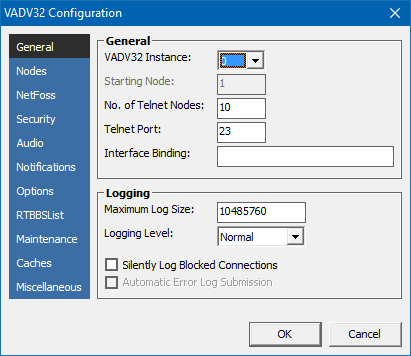
This window contains VADV32's general configuration
options:
-
VADV Instance - You may run multiple copies of VADV32
on the same computer by assigning each instance an unique
number.
Default = 0
-
Starting Node - This is the node number
you want to begin accepting telnet connections on.
On an all telnet system, you would normally set
this to "1". It is recommended that you
do not change this value. Any dial-up nodes should
be configured after the last telnet node.
This option is disabled and managed by VADV32 if
Telnet-Only System is enabled.
Default = 1
-
No. of Telnet Nodes - This is the total
number of telnet connections you want to allow.
If you set this value higher than the maximum number
of connections (in VConfig Main Configuration),
then this value will be automatically scaled back.
You must also have a valid registration for the
number of connections you wish to allow. If you
only have a 10 node registration and you set this
value higher than 10, then any connections on node
eleven or higher will be denied by the BBS.
Default = 1
-
Telnet Port - This is the TCP port to
listen for connections on.
Default = 23
-
Interface Binding - If you have multiple network
interfaces on the computer, you can select individual
ones to bind the telnet port to. Enter the IP addresses
of each interface seperated by a comma. Default = ""
-
Maximum Log Size - You can specify the
maximum size of the VADV32.LOG (in bytes). Once
the log has reached this size, the log will be saved
as VADV32.OLD and then the log will be reset.
Default = 10485760 (10MB)
-
Silently Log Blocked Connections - If enabled,
any blocked connections will not be shown in the main
form's textbox. Blocked connections will be logged in
the VADV32 log.
Default = Off
-
Logging Level - The amount of events to log.
Default = Normal
-
Minimal - Logs events and connections.
-
Normal - Logs each connection step. VADV32
will create a DEBUGx.LOG in the DATA directory.
This file will contain any errors that occur in the
DOS window before Netfoss has loaded. This can be
useful for debugging Netfoss errors.
-
Session - The entire DOS window session will
be saved to DEBUGx.LOG in the DATA directory. When
this is turned on, you cannot "spy" on users since
the console window output has been redirected.
-
Automatic Error Log Submission - If enabled, any
error messages generated by VADV32 will be emailed to
VADVBBS.com support for examination. This is used to eliminate
bugs. You must have Internet email configured and operational
in order for this to work.
Default = Off
|
|
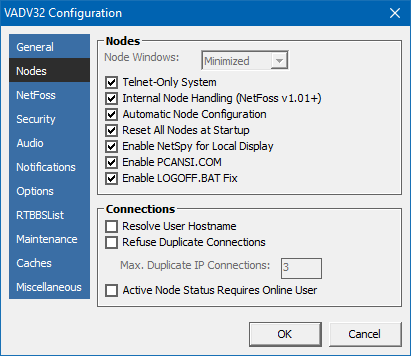
This window contains VADV32's node configuration
options:
-
Node Windows - When a user connects,
the BBS node is loaded into a DOS window. You can
specify what state this window should be started
in: Normal, Minimized or Hidden.
Default = Minimized
-
Telnet-Only System - Enabled by default and
recommended if you only have telnet nodes (no dial-up).
VADV32 will automatically manage several parts of the
configuration.
Default = On
-
Internal Node Handling - This determines
whether VADV32 will load the BBS nodes, or if the
LOADBBS.BAT will load the nodes. If enabled, then
LOADBBS.BAT will NOT be used to load the BBS session.
VADV32 will load NetFoss using the settings you
specify. Generally you do not need to modify the
values.
If you use the internal node handling, then VADV32
will use the value for LOGOFF.BAT in VConfig to
determine if LOGOFF.BAT should be executed after
a user logs off. This option is in Virtual Advanced
Main Configuration.
Versions prior to 2.1 do not have this option and
must use LOADBBS.BAT to load NetFoss and the BBS.
Default = On
-
Automatic Node Configuration - If you
enable this then when a user connects, the node's
settings will automatically be changed to work with
VADV32. This will prevent any channel configuration
errors.
Default = On
-
Reset All Nodes at Startup - If enabled, all
nodes will be reset to the defaults when VADV32 is
loaded. This cleans up any potential data left from
a prior session that may have ended unexpectedly.
Default = On
-
Enable NetSpy for Local Display - If enabled,
NETSPY.EXE will be used to load the local display. You are
still able to fully interact with the node but are not
at risk to accidentally close the connection by closing
the window. If disabled, you view the node's actual console
window.
Default = On
-
Enable PCANSI.COM - This will use PCANSI.COM for
local ANSI decoding.
Default = On
-
Enable LOGOFF.BAT Fix - This tells VADV32 to
run LOGOFF.BAT itself and not rely on VADV to handle it.
There is a VADV bug which causes a logoff error when logged
in locally. This option should be disabled if you run any
dial-up nodes.
Default = Off
-
Resolve User Hostname - If this is enabled,
when a user connects, VADV32 will attempt to resolve
the user's hostname. This may take a few seconds
if the hostname cannot be resolved. The hostname
is logged and is also accessible in the TCPIP.CFG
file.
Default = Off
-
Refuse Duplicate Connections - If enabled,
VADV32 will check the IP address of an incoming
connection to see if it is already online. If the IP
is already using a node, a message will be displayed
to the user and then be disconnected.
Default = Off
-
Max. Duplicate IP Connections - You may set the number
of duplicate connections to allow before blocking.
Default = 3
-
Active Node Status Requires Online User - This performs
an additional check when calculating active minutes. If enabled,
VADV32 will check to verify a user is logged in to the BBS in
order to count it as "active".
Default = Off
|
|
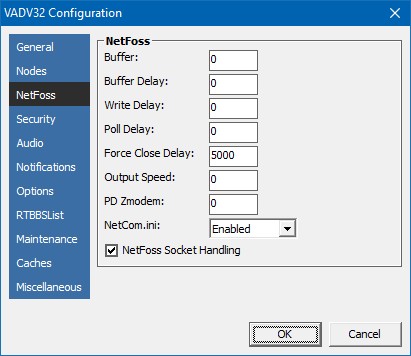
This window contains VADV32's Netfoss configuration
options:
-
Buffer - The maximum amount of
outgoing data to buffer before sending the TCP/IP
packet to Winsock.
Set to 0 for NetFoss default (1280).
Default = 0
-
Buffer Delay - The minimum delay time
that data was last received before writing out the buffer.
Set to 0 for NetFoss default (100).
Default = 0
-
Write Delay Time - The maximum
amount of time to wait before sending the buffered
TCP/IP packet to Winsock.
Set to 0 for NetFoss default (350).
Default = 0
-
Poll Delay - The number of status polls performed
before a sleep delay.
Set to 0 for NetFoss default (500).
Default = 0
-
Force Close Delay - The number of milliseconds to wait before
forcing a node's console close.
Set to 0 for NetFoss default (0).
Default = 5000
-
Output Speed - This controls the output speed. Lower values mean
faster output.
Set to 0 for NetFoss default (0).
Default = 0
-
PD Zmodem - Used to tweak the speed of file
transfers when using the PD Zmodem protocol.
Set to 0 for NetFoss default (175).
Default = 0
-
NetCom.ini - If enabled, NETCOM.INI will be used to pass
parameters to NetCom. If disabled, command line parameters will be used.
Some settings can only be changed by using NETCOM.INI.
Default = Enabled
-
NetFoss Socket Handling - Requires NetFoss v1.0
or higher. This allows socket termination to be handled
by NetFoss. Nodes are closed more gracefully and not
forced closed.
Default = On
|
|
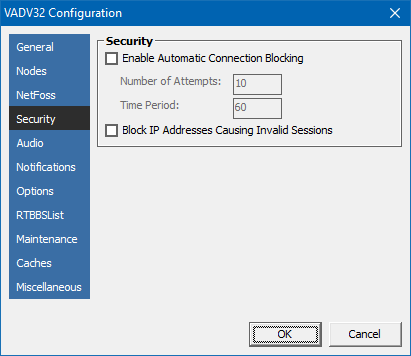
This window contains VADV32's Netfoss configuration
options:
-
Enable Automatic Connection Blocking - VADV32 can be configured to automatically
block IP addresses that are repeatedly connecting to the BBS. This is used
to help control port scanners or malicious users from taking over your
nodes.
Default = Off
-
Number of Attempts - The number of connection attempts within the time
period in order to become blocked.
Default = 10
-
Time Period - The time period (in seconds) in which the connections must take
place to become blocked.
Default = 60
-
Block IP Addresses Causing Invalid Sessions - If enabled, any connection that
causes an "invalid session" will be blocked for a duration. Invalid sessions can be
caused by port scanning or any connection that closes very quickly after opening.
Default = Off
|
|
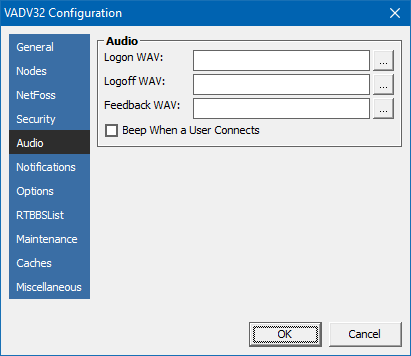
This window contains VADV32's audio configuration
options:
-
Logon WAV - A WAV file to be played when a user
connects to the BBS.
Default = ""
-
Logoff WAV - A WAV file to be played when a user
disconnects from the BBS.
Default = ""
-
Feedback WAV - A WAV file to be played when new
SysOp email is detected.
Default = ""
-
Beep When a User Connects - If enabled,
VADV32 will emit a "beep" when a user connects.
Default = Off
|
|
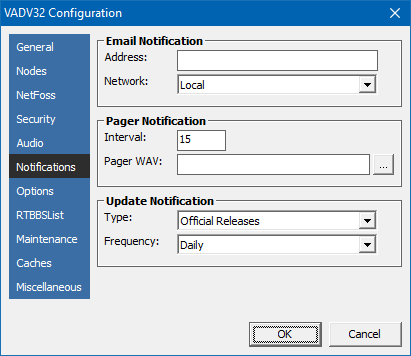
This window contains VADV32's notification configuration
options:
-
Email Notification - You can specify an
email address and network to send a notification
message when new SysOp feedback is received.
-
Pager Notification - If the interval is greater than
zero, VADV32 will check for a flag file named VA32PAGE.FLG.
If found, VADV32 will read the first line and do one of three actions:
-
Audio - VADV32 will play the specified WAV file.
-
Video - VADV32 will show a small notification in the
lower right corner of the primary monitor alerting
that a user has paged.
-
Both - VADV32 will play the WAV and show the visual notification.
See the section in Other VADV32 Features and Information
for more information.
-
Update Notification - You can choose
to have VADV32 look for program updates on a regular
basis. If a newer version is available, then you
will be notified and provided a direct link to the
update. This feature now uses the V32 Update
application.
|
|
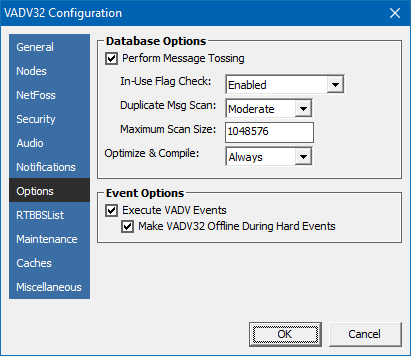
This window contains VADV32's options:
-
Perform Message Tossing - If enabled,
VADV32 will monitor the BBS for any network messages
that need to be processed. If you are running node
one at the WFC for whatever reason, you may want
to turn this off since node one will perform this
monitoring. If you are running an all telnet system,
then enable it.
Default = On
-
In-Use Flag Check - This option checks for the
B*.FLG files used to specify that network tossing is
currently active. Options are:
-
Enabled - If the flag is found, tossing is aborted.
-
Disabled - Message tossing will execute even if the
flag exists.
-
Disabled w/ Delete - If the flag is found then it
will be deleted and message tossing will be performed.
Default = Enabled
-
Duplicate Msg Scan - This option determines
what level of duplicate message scanning to perform
before tossing messages:
-
Disabled - No scanning performed.
-
Loose - Check message headers only.
-
Moderate - Check message headers and
message content.
-
Strict - Check message headers, message
content and VADV system information.
Default = Moderate
-
Maximum Scan Size - If the size of messages exceed
this amount, duplicate message scanning will not be performed.
This option was added because performing duplicate message
scanning on an excessive amount of messages would bog down the
system and take too long to finish.
Default = 1048576 (1MB)
-
Optimize & Compile - This option controls
what action to take after editing databases within
VADV32:
-
Disabled - No action occurs.
-
Ask - VADV32 will ask if you want to
optimize databases and compile network
information.
-
Always - VADV32 will automatically optimize
databases and compile network information.
Default = Always
-
Execute VADV Events - If enabled, the
scheduled events in VConfig will be executed. Multiple
events scheduled at the same time will be run one
after the other. "Hard" events are treated as "soft"
events (no user booting).
Default = On
-
Make VADV32 Offline During Hard Events - If enabled,
VADV32 will go into offline mode while it is performing
a "hard" event.
Default = On
|
|

This window contains VADV32's RTBBSList configuration
options:
-
Enable RTBBSList - Allows Real-Time BBS List
functionality and enables the fields below.
Default = Off
-
RTBBSList URL - The full URL to the update page
for the BBS List service.
-
RTBBSList Username - Your username for
the Real-Time BBS List service.
-
RTBBSList Password - Your password for
the Real-Time BBS List service.
-
Interval - The number of minutes to pass before
updating the BBS List entry.
Default = 5
-
Enable Information Display - If enabled, the
RTBBSList status will be shown on the main VADV32
window. If disabled, memory information will be shown.
|
|
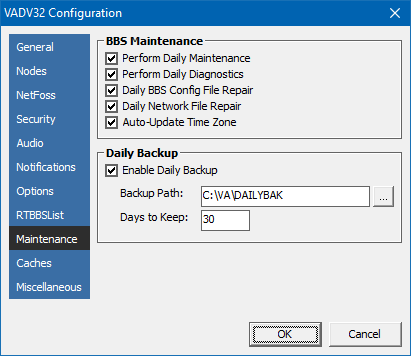
This window contains VADV32's maintenance configuration
options:
-
Perform Daily Maintenance - On an all
telnet system, normally this is enabled. Each night
at midnight, the BBS statistics are reset and logs
are rotated. This needs to occur each night. If
you are running node one as a dial-up node or it
is at the WFC screen for whatever reason, then this
option should be disabled (node one does this maintenance).
Default = On
-
Perform Daily Diagnostics - Each night during daily maintenance,
a diagnostic test will be performed searching for invalid
paths and common networking errors. If any problems are found
an email will be sent to the SysOp.
Default = On
-
Daily BBS Config Repair - Each night during daily maintenance,
various configuration files will be scanned for common errors and
fixed if needed.
Default = On
-
Daily Network File Repair - Each night during daily maintenance,
various network configuration files will be scanned for common
errors and fixed if needed.
Default = On
-
Auto-Update Time Zone - If enabled,
VADV32 will automatically update the timezone
setting in VADV's main configuration. It checks
for any changes at the program start and
every 30 minutes. It is recommended that
you keep this enabled since it is
important that the timezone be
accurate.
Default = On
-
Perform Daily Backup - Each night during daily maintenance,
configuration and data files will be archived into the path configured below.
Default = On
-
Backup Path - The location to store the archives.
Default = .\DAILYBAK
-
Days to Keep - The number of backups to keep before deleting
the oldest file.
Default = 30
|
|
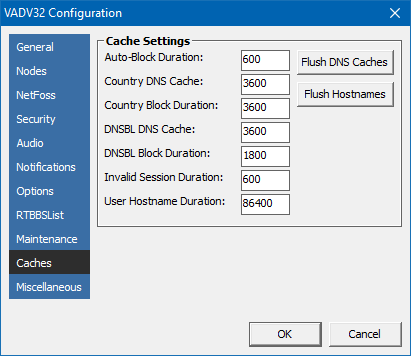
This window contains VADV32's caching options.
|
|
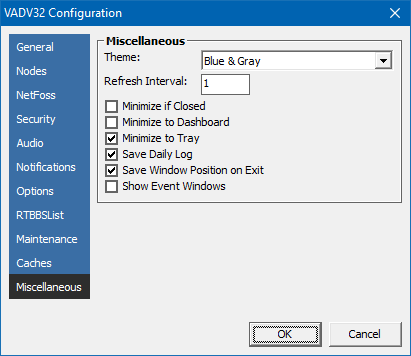
This window contains VADV32's miscellaneous configuration
options:
-
Theme - You can change the color theme of the main
VADV32 window by changing this option.
Default = Blue & Gray
-
Refresh Interval - You can set the number of
minutes for VADV32 to update the BBS statistics,
hard drive list and alert icons.
Default = 1
-
Minimize if Closed - If enabled then when you
press the "X" to close the window, it will only minimize
it instead of terminating the application.
Default = Off
-
Minimize to Dashboard - VADV32 can be minimized
to a very small window by using this option. This will
keep VADV32 visible but out of the way.
Default = Off
-
Minimize to Tray - You can minimize VADV32
to the system tray by enabling this option. This
saves space on the taskbar and also allows you to
right click the tray icon for quick options.
Default = On
-
Save Daily Log - If enabled, VADV32 will remember
the daily log and restore it when VADV32 is loaded.
Default = On
-
Save Window Position on Exit - If enabled,
the window coordinates will be saved when VADV32
is exited. When VADV32 is loaded, it will use these
coordinates to position the window. If disabled,
then the window will always be centered on the screen
when loaded.
Default = On
-
Show Event Windows - If enabled, when
daily maintenance and message tossing is performed,
the windows that are processing these event will
be visible and accessible. Occasionally there is
a sharing violation and with the windows visible
you are able to exit the event cleanly.
Default = Off
|
|
VADV32 has portions of
the VConfig utility built-in to make it more convenient
to configure your BBS. Each option is briefly explained
below. For more detailed information about these options,
consult the VConfig documentation file.
-
Main Configuration - Contains the general
options for your BBS.
-
Channels - Configure the
communications aspects of VADV. VADV32 can automatically
handle this portion of your BBS, but you may choose
to manually control it if you have special requirements
such as dial-up nodes.
-
Paths - Edit the path settings
for your BBS.
-
Databases - Configure the
message base and file directories of your BBS.
-
Message Bases - The "message subs"
or simply "subs" of your BBS.
-
File Directories - The file directories
that contain the files your users download from
your BBS.
-
Custom Databases - Special databases
created to work with script-based applications.
-
Optimize & Compile - This will optimize
databases and compile network information.
-
Optimize Database Configuration -
This compresses and reorganizes the DATABASE.CFG
file so that database groups and databases can
be accessed most quickly.
-
Compile Network Information - Recompiles
the data which establishes the "connection"
between a database and a networked message area
or file area.
-
Database Auto-Setup (HDD/CD-ROM) - VADV32
can scan a specified directory and sub-directories to
create databases. Use this along with VFileSyn to quickly
setup databases and add files.
-
Make NEWS.LST for NNTP - This creates
the ASCII file NEWS.LST which is used by VISK's
NNTP software. The file is created in your main
VADV directory, but must be moved to your Windows
directory in order for VISK to use it.
-
QWK Numbering - Options
to handle QWK numbering easier.
-
Auto-Number Message Bases - This
will automatically assign all messages bases
an unique QWK number. Existing QWK numbers
will be reset and reassigned.
-
Reset (Turn Off) All QWK'd Message
Bases - All databases' QWK number will
be reset to zero.
-
Network Configuration - Configure the
networks used by your BBS.
-
VirtualNET - Allows you to configure
VirtualNET (network #1) for your BBS.
-
VNET Networks (Type 1) - This will
lists all available VirtualNET networks and
allow you to configure them for your BBS.
-
Virtual LIVE (Type 2) - Install or
uninstall Virtual LIVE for your BBS.
-
Internet (Type 3) - Configure the
Internet (UUCP) for your BBS.
-
FIDOnet (Type 4) - Configure FIDOnet
type networks for your BBS.
-
QWK Networks (Type 5) - This will
list all available QWK networks and allow you
to configure them for your BBS.
-
Edit Available Networks - This allows
you to edit your NETWORKS.LST file.
-
Doors Configuration - Configure the external
programs listed in the BBS's door menu.
-
Events Configuration - You can configure
up to 48 timed events per day, such as your external
daily maintenance routine and door maintenance.
-
Multi-Feedback Configuration - Configure
the feedback capabilities of your BBS. This allows
users to E-Mail you or any Co-SysOps quickly and
easily.
-
Protocols - Transfer protocols:
-
Download Protocols - Edit the transfer
protocols used by your users to download files.
-
Upload Protocols - Edit the transfer
protocols used by your users to upload files.
-
Random Messages - Configure VADV's "random
messages" function, which can display one-, two-,
or three-line messages right before the user initially
sees the main menu.
-
Text Sections - Configure text files
available for your users to view. Common files include
game scoreboards and rules for your BBS.
-
User Quick Validation - Configure the
nine profiles that allow you to change users' security
levels, time limits and access flags from the user
editor.
-
Voting Booth - Configure survey's in
which your users can vote.
-
Archive Configuration - Configure the
file archivers used by the BBS. You must know
the hex identifier for the archiver to add
new ones.
-
Autoresponder Configuration - Configure
the autoresponder function of the BBS, which allows
automated responses to be sent to those who email
your BBS at a special address.
-
IRC Servers - Configure the IRC servers
your users can access while in teleconference. VISK
is required.
-
Teleconference Actions - Configure custom
actions your users can perform while in teleconference.
-
Teleconference Rooms - Configure the
name and moderator of the different rooms available
in teleconference.
-
FIDOnet Text Configurations - Various text file
configurations for FIDOnet.
- AREAS.BBS
- MAGIC.FID
- PHONE.FID
- TICS.BBS
-
VADV Text Configurations - Various text file
configurations.
VADV32 uses the following:
- All Nodes in Use (BUSY)
- Duplicate Connection (DUPECONN)
- Offline Message (OFFLINE)
These are the various TXT files that VADV
uses for certain features:
- Call-Back Verifier (CBV)
- Free Downloads (FREEDL)
- Network-Only Message (NETONLY)
- New User Email (NEWUMAIL)
- New User Welcome (NEWUSER)
- Restricted Uploads (EXCLUDE)
- Restricted Usernames (TRASHCAN)
- Zip Comment (ZIPCOMNT)
|
|
You can configure VISK directly from VADV32. In order
for this to appear in VADV32, you must have VISK installed.
|
|
You may restrict certain countries from
connecting to your BBS. When a user connects,
VADV32 will determine if the caller is from
a blocked country by the connecting IP address.
|
|
If you enable the DNSBL (DNS Blackhole List) feature,
then you can specify blackhole databases to query when an
incoming connection is created. There are various blackhole
databases available for use for different purposes. What it
does is query the blackhole database for the IP address of
the connecting server. If the IP address exists in the database
then the connection is refused. If the IP is not present, then
VADV32 allows the user to connect normally.
If caching is enabled then any IP addresses that are rejected are
cached. This speeds up lookups and reduces the stress on the databases.
|
|
This is an extension of the IP restrictions below. You can
specify hostnames to blacklist or whitelist. Each hostname will
be resolved to their IP address and internally added to the
appropriate IP restriction list. This is useful when you need
to allow or block domains which may have dynamic IP addresses.
|
|

You can make VADV32 block certain IP addresses from
connecting, or you can only allow certain IP addresses
to connect. The netmask can also be modified to allow or block
a range of IP addresses.
Whitelisted IP addresses bypass all filters and are
allowed to connect even if found on the blacklist.
You can specify wildcard IP addresses by using an
asterisk in the IP address. For example, if you blacklist
*.*.*.* then no one is allowed to connect except IP's found
in the whitelist. Note: If a wildcard is used, the netmask
will automatically be
set to 32.
|
|
You can filter certain messages from entering your
system. This filtering takes place before message
tossing is performed. You must have message dupe
protection enabled in VADV32's configuration for
filtering to work.
You do not need to enter information in all of the
areas of the form. Just enter the minimum amount of
information and leave the other fields blank.
|
|
You can configure up to nine VADV32
shortcuts. These are programs you wish
to have easily accessible from within
VADV32. They will appear in a new
menu as well as each shortcut having its
own hotkey.
|
|
VADV32 supports file triggering. What this
means is that you can specify a certain file
for VADV32 to keep a watch out for. If this
file exists then VADV32 will execute an
application that you configure. Examples of
uses for this feature is to automatically
run message tossing software after message
packets are received. VADV32 checks for
the existance of the trigger once each minute.
|
|
You can setup events that will be executed when
VADV32 is loaded. These events will be executed
everytime that VADV32 is loaded so you need to be
careful what you configure. If you enable it,
VADV32 will try to detect if the program is already
running and if so it will not try to load another
instance. This only works for Windows programs.
Console or DOS programs will be executed everytime
since they cannot be detected.
|
|
This is a very useful
option when configuring VADV32. When you have changed
VADV32's starting node number and/or the maximum number
of telnet connections, then it is a good idea to use
this. It starts from the starting node and changes each
channel configuration to the optimum settings for VADV32.
This saves you the work of editing each channel individually!
This is disabled if you have automatic node configuration
enabled.
|
|
|